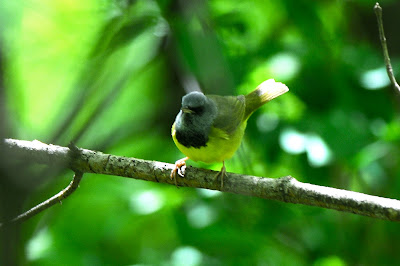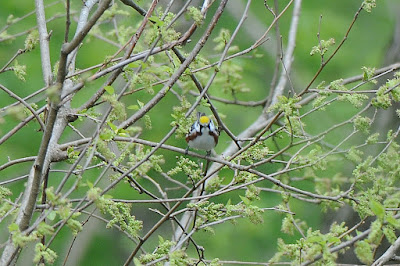There are a couple of books out there that I honestly think every serious birder should have. Does the new Crossley ID Guide to eastern birds go on that list? Well, more on that later. A little more about the book itself.
The Crossley ID Guide: Eastern Birds is a 530 page book published by Princeton University Press. It was published in 2011 and is listed as $35.00.
Size: The first thing that you will notice when you pick up this book, if you're able to, is that it's BIG. This is one of the largest bird books on my shelf; it's larger than the Sibley Guide in almost every respect except in the number of pages (The Crossley Guide is 530 pages from cover to cover). Here are some photos of it next to the Sibley Guide:


General layout: Most basically, this is a photographic guide but it's unlike any other photographic guide I've seen. Why? Instead of just one or two photos per species, Crossley photoshopped in as many as 50 different birds of the same species, each in a different posture (flying, flocks, perched, foraging, etc). It's a very creative way of displaying some of the behavior exhibited by various species. For example, on page 276 for the White-crowned Pigeon, Crossley shows the pigeons perched in a treetop (which is accurate). On page 267 for the Burrowing Owl, he shows BUOWs on fence posts and even some owl heads poking up over a mound of dirt (also accurate).
Each common eastern species usually has an entire page devoted to it (keep in mind that this book covers eastern birds only, NOT coast-to-coast). For example, page 416-417 has the Blackburnian Warbler on the left (showing 15 BLBWs) and Cerulean Warbler on the right (showing 10 CERWs). For less common eastern species such as vagrants, Crossley packed up to four species on a single page (Hammond's Flycatcher, Dusky Flycatcher, Gray Flycatcher, and Cordilleran Flycatcher). Below each collection of photoshopped birds is the common and scientific name, a brief description of the bird, a line or two about behavior, and some ID tips. Also included for most species is a range map.
Range maps: In my opinion, any bird book with accurate range maps is a step ahead of others (as a beginner, I put in a lot of my time studying maps). Crossley's range maps seem to be very well done. Similar to other bird books, he portrays year-round areas with purple, summer-only in orange, winter-only in blue, and vagrancy patterns with a dotted line. On pages with multiple species, however, the range maps are quite small and it's difficult to make out fine details.
Backgrounds: Crossley does something that I've never seen before; he put a lot of effort into the background of each layout. He chose to paste all the birds on a landscape typical of where you might find that species; the tern backgrounds are of beaches, the thrush backgrounds are of woods, and ibis backgrounds are of marshes, etc. One page in particular really stood out to me as outstanding: Brown Creeper (pg. 379). Finally a book that shows exactly how you will see your first Brown Creeper!
I can safely say that I've never seen so many people in a bird book. That's right, PEOPLE. Whether it is the older gentleman peering at you from behind an Eastern Phoebe, the 4 gentlemen playing golf behind the Chipping Sparrows, or a bikini-clad woman on a beach behind some Bar-tailed Godwits, the backgrounds didn't cease to amuse me. Plus, Crossley's affinity for Cape May is obvious; just look at the writing on the boats behind the Least Terns and Laughing Gulls!
4-letter bird codes: Finally, a book with the shorthand alpha codes! I prefer the use of the 4-letter bird codes for checklists (NOPA, CERW, BBWD, etc). No book that I know of has actually included these before so I am happy to see that Crossley included them twice; on each individual species page and in a 4-page index at the end. Now if only I could actually remember to use RNEP for Ring-necked Pheasant and RNPH for Red-necked Phalarope (don't get me started on why those are the official codes for those species, it doesn't make sense in my head).
Quality of photos: Richard Crossley is a well-known and skilled photographer. No argument there. The number of photos he must have taken for this guide was probably astronomical. He took 99% of the 10,000 photos included in this guide himself. I'm only a beginner when it comes to bird photography but I did notice several photos that were actually blurry or out-of-focus (Bald Eagle, Nashville Warbler, Swainson's Warbler, Connecticut Warbler). I can't say I blame someone who can't get a perfect photo of a CONW or SWWA though! It is hardly an issue to quibble with.
Audience: I've struggled with figuring out what the targeted audience is of this book. It's toted as suitable for all skill levels but I disagree. I feel that this book would target mostly beginner birders. If someone were to take up an interest in birds, this might be a great first choice given that it visually shows habitat and behavior. However, I don't think the most-seasoned birders will learn much from this book. I would argue it's more of a novelty item suitable for a sturdy coffee table compared to being in my backseat while I'm out birding. So ultimately, given the audience, this book could be absolutely mind-blowing or just a collection of pretty photos.
Small quibbles and quirks: I wondered a few things as I looked through this book. A) Isn't it a "Saltmarsh Sparrow" and not "Sharp-tailed Sparrow"? He got the "Nelson's Sparrow" right but goofed on the other one. Whoops! B) What's with the hanging lightbulb on the BRTH page? Is that needed for the ID? And last but not least, C) is that GBBG really going to eat that AMCO??
So in short, what are my main thoughts? I think Crossley has taken bird identification down a new and refreshing road and his main concept is a brilliant one. The aspect of displaying behavior through photographs is a new concept and one that I hope continues to catch on with field guides. I would absolutely love to see this type of guide be streamlined down into a field-oriented book with more side-by-side comparisons with less of a focus on amusing props and backgrounds. The book states that it will make me a better birder; will it? Probably not... but it WILL make me a stronger one.
PROS:
* Uses photos to illustrate behavior and habitat
* Shows various postures per species
* Includes 4-letter bird codes
* Good range maps
CONS:
* Large size
* Only eastern species are included
* Poses are non-consistent (no side-by-side comparisons)
* I catch myself being distracted and playing "Where's Waldo" to find all the birds per page
WHAT I WOULD CHANGE:
* I liked the scenarios with 2 species per page (pg. 301); it creates the opportunity to compare side-by-side. Trimming down the full-page scenarios would also help trim down the overall size of the book.
* I would remove the background props that don't help the identification (boats, buildings, people)
I encourage you to find more information about the book, including seeing plates, by visiting:
http://press.princeton.edu/titles/9384.html
Disclaimer: I received a complimentary copy from the publisher for review purposes, but the viewpoint expressed in this article is entirely my own.

















































